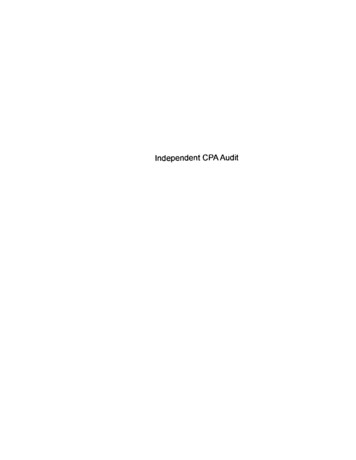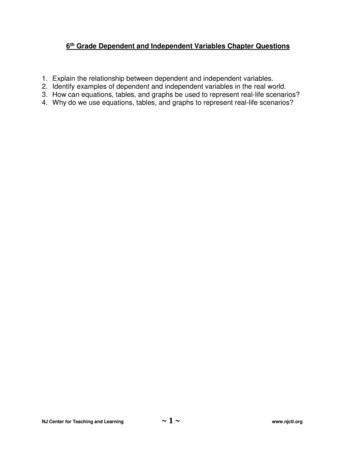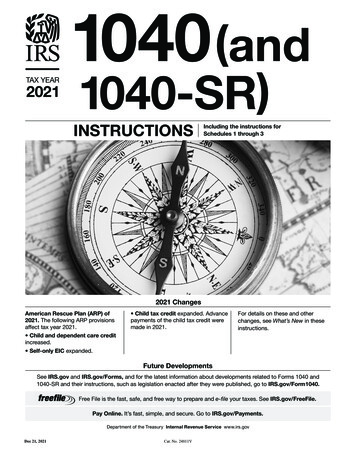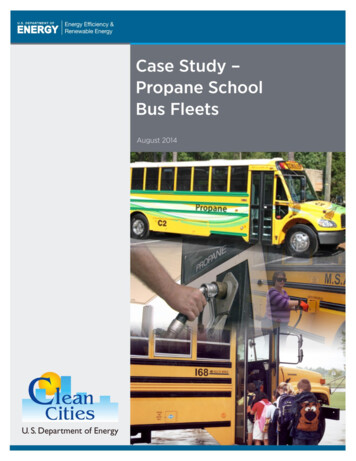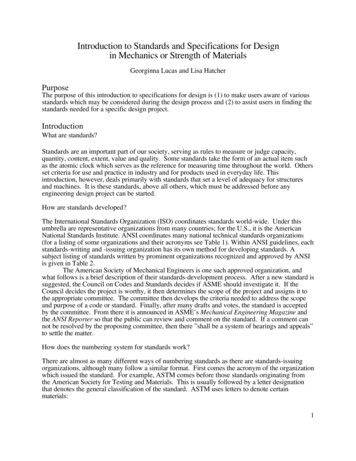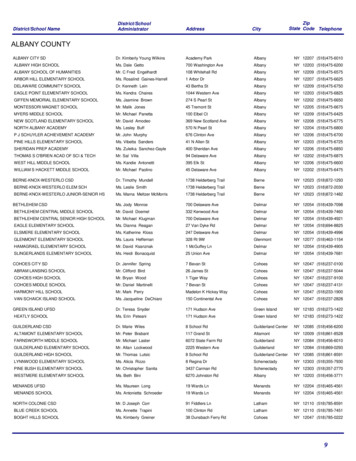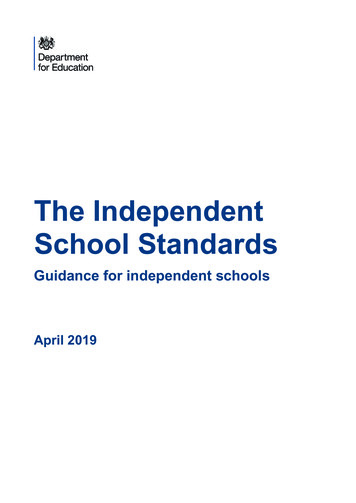
Transcription
The IndependentSchool StandardsGuidance for independent schoolsApril 2019
ContentsSummary3Expiry or review date3Who is this publication for?3Main points4Introduction4Part 1: Quality of Education5Part 2: Spiritual, Moral, Social and Cultural development of pupils (SMSC)18Part 3: Welfare, health and safety of pupils27Part 4: Suitability of staff, supply staff and proprietors34Part 5: Premises of and accommodation at schools38Part 6: Provision of Information39Part 7 – Manner in which complaints are handled44Part 8: Quality of leadership in and management of schools46Annex48Useful resources and external organisations48Other relevant departmental advice and statutory guidance48Other departmental resources482
SummaryThis is guidance from the Department for Education (DfE). This guidance is nonstatutory. It has been produced to help proprietors and others understand the obligationsunder the independent school standards contained in the Schedule to the Education(Independent School Standards) Regulations 20141 (referred to in this document as ‘theRegulations’). Inspectors will take this guidance into account when reporting to theSecretary of State on the extent to which the independent school standards are beingmet, or are likely to be met, in relation to an independent school. The department wouldalso take it into account when taking decisions about regulatory or enforcement action onindividual schools. The aim of this document is to provide supplementary guidance onbest practice in complying with the standards and sets out the department’sunderstanding of them. It does not purport to be definitive guidance on the meaning ofthe standards themselves, which only a court can give.A number of the obligations under the independent school standards require a proprietorto ‘have regard to’ guidance or standards. This requirement does not mean that theguidance or standards must always be followed to the letter but any departure from therequirements set out in the guidance or standards must be considered and based onappropriate reasons, and proprietors will therefore need to record the justification behindany departure.This guidance should be read alongside the standards themselves. It is not intended tobe a full explanation of every area of the standards’ requirements: rather it seeks to givesome helpful additional detail in some areas for which questions are sometimes raised byschools.Expiry or review dateThis guidance will be reviewed before December 2020.Who is this publication for?This guidance is for school proprietors, school staff and governing bodies of independentschools. It is proprietors who have an obligation to ensure that a school meets thestandards, but in this document, the word ‘school’ is often used for the sake of clarity (forexample ‘the school should have in place’).1S.I. 2014/3283, available at nts/made3
Main pointsFrom 5 January 2015 a new set of independent school standards came into force.Inspection experience since then suggests that a detailed advice document would beuseful for schools. A consultation on draft guidance was held from 14 March to 5 June2018. A government response document setting out an analysis of consultationresponses is being published separately.The content of the department’s November 2014 advice published in November 2013and November 2014 on Spiritual, Moral, Social and Cultural (SMSC) development ofpupils in independent schools has been subsumed into this document, but in revisedform. Therefore, those two advice documents have been withdrawn.The guidance is set out for individual standards but where there are links to otherstandards, these are cross-referenced.This document does not cover in significant detail the requirements in Part 5 of theindependent school standards (which relate to premises of and accommodation atschool). This is because there is already separate departmental advice on thoserequirements so far as they relate to premises and that advice has not been revised.Therefore, that advice should still be referred to, since it supplements what is said hereon the Part 5 requirements. A link to it can be found at the end of this publication.EnquiriesAny enquiries about this guidance can be made by email oduction1.1 On 5 January 2015 the current set of independent school standards, contained inregulations made under section 94 of the Education and Skills Act 2008, came into force.The original text of the Education (Independent School Standards) Regulations 2014(‘the Regulations’) is available at the link shown in the footnote.1.2 DfE believes that the great majority of schools are already meeting the standardsthrough good practice. However, results of school inspections undertaken at schoolssince January 2015 suggest that compliance would be improved if schools had access todetailed guidance on the department’s understanding of the meaning of the standards.4
1.3 The standards are contained in the Schedule to the Regulations. That Schedule isdivided into eight different Parts, with each Part covering a different subject-matter ofstandard. The format of this guidance is that for each Part (except Part 5, the subjectmatter of which is school premises and accommodation), the requirements are explainedin lay terms, following an introductory section which sets out the department’s aims ofthat Part as a whole.1.4 At the same time that the current standards came into force, most of the provisions inChapter 1 of Part 4 of the Education and Skills Act 2008 relating to the regulation ofindependent schools in England which had not already been commenced, were broughtinto force. Consequently, independent schools in England are now (mostly) regulatedunder Chapter 1. A notable exception to this are the provisions relating to the approval ofmaterial changes to registered details (contained in sections 101-105 of the 2008 Act).These have not yet been brought into force and instead section 162 of the Education Act2002 continues to apply. A number of the 2008 Act provisions are explained in thedepartment’s registration guidance, which is available from a link shown at the end of thisdocument.1.5 The revised standards should be seen in the context of successive policy statementsby DfE ministers that education standards must be raised across the board in all schools.Ministers are now intervening in a greater number of state funded schools, to ensure thatthe educational provision is good and, in parallel, these strengthened standards haveraised the bar for the independent sector. The Secretary of State has also signalled thathe will be taking a firmer approach to enforce the standards when there is evidence ofnon-compliance. This is reflected in the policy statement on regulatory and enforcementaction which is published alongside this guidance. All of the standards are mandatoryand should be met by independent schools at all times except where they do not apply toparticular types of school.1.6 DfE anticipates that schools will have copies of all policy documents (or schemes ofworks and plans) which are required by the independent school standards available inEnglish, to facilitate any inspection. This will assist inspectors in collating the evidenceabout compliance with the relevant standards.Part 1: Quality of Education2.1 The overall purpose of Part 1 is to ensure that a school has a curriculum whichcovers a broad range of subject disciplines, delivered through teaching that will enable all5
pupils to make good progress according to their abilities, and that such progress isproperly assessed as part of a continuous process which feeds back into lessons.2Detailed commentary on the standards (paragraph references below and in followingpages are to those contained in the Schedule to the Education (Independent SchoolStandards) Regulations 2014 (“the Regulations”))2.—(1) The standard in this paragraph is met if—(a) the proprietor ensures that a written policy on the curriculum, supported by appropriate plans and schemesof work, which provides for the matters specified in sub-paragraph (2) is drawn up and implementedeffectively; and(b) the written policy, plans and schemes of work–(i) take into account the ages, aptitudes and needs of all pupils, including those pupils with an EHCplan; and(ii) do not undermine the fundamental British values of democracy, the rule of law, individual liberty,and mutual respect and tolerance of those with different faiths and beliefs.2.2 The basic requirement in paragraph 2(1) is that a proprietor ensures that a schoolhas documentation which covers three areas: (a) the school’s overall approach to itscurriculum (ie the subjects it teaches), and this written policy must cover each of thematters in paragraph 2(2); (b) proposals for how that written policy on curriculum will beimplemented (‘plans’) and (c) detailed specifications for each subject of what is to betaught throughout the year for each year group taking that subject (‘schemes of work’).Schools are advised to have a copy of these documents available in English, to facilitateany inspection. If the school takes a holistic approach to curriculum, for example teachinggeography, language and history through a project-based approach, then thedocumentation must reflect this but it will also need to provide for how each of thematters specified in sub-paragraph (2) of this standard will be covered through thatapproach. There is a link between the overarching requirements in paragraph 2(1)(a) andparagraph 3(a), which requires that pupils make good progress in the subjects taught.These are supported by paragraph 2(2) which specifies the areas to be covered in thewritten policy. Paragraph 2(1)(a) also requires that the written policies for these areas ofstudy are to be effectively implemented, and this will be a key point for inspectors.2Whilst the duty to produce an accessibility plan is a separate duty, outside the independent schoolsstandards (see para 112d below), a school’s plan is likely to be relevant to how it plans and deliver itscurriculum.6
2.3 In addition, proper consideration should be given to ensuring that the written policy,plans and schemes of work meet the needs of all individual pupils in terms of their ages,needs and aptitudes, including those with special educational needs.2.4 So far as fundamental British values are concerned, the aim is to ensure that theeducation which it is planned to offer to pupils is in all aspects not in conflict with, orinconsistent with, any of them. A school is unlikely to meet the requirement in paragraph2(b)(ii) if its policy on curriculum or the supporting plans and schemes of works, forexample:a. include material in history lessons which promotes non-democratic politicalsystems rather than those based on democracy, whether for reasons of faith orotherwise;b. teach that the requirements of religious law permit the requirements of Englishcivil or criminal law to be disregarded;c. are designed to suggest to pupils that some or all religions are wrong and thattherefore those who follow them are not worthy of respect. For the avoidance ofdoubt, teaching that some religions, all religions, or atheism/agnosticism arewrong does not conflict with fundamental British values, so long as it is made clearthat adherents of those belief systems should be treated with respect.2. (2) For the purposes of paragraph (2)(1)(a), the matters are—(a) full-time supervised education for pupils of compulsory school age (construed in accordance with section 8of the Education Act 1996), which gives pupils experience in linguistic, mathematical, scientific, technological,human and social, physical and aesthetic and creative education;2.5 This paragraph sets out the requirements for the range of curriculum areas that mustbe covered in a school’s curriculum policy and taught to pupils – given the obligation toeffectively implement. A school must be able to show that each specified area is covered,for each stage of study by pupils who are of compulsory school age. However, there iswide discretion for schools as to how each one is covered. For example, schools whichdiscourage or ban the use of IT/electronic media, or whose pupils cannot use them dueto disability, may legitimately reflect this in their approach to technological education, butshould still ensure that pupils have conceptual familiarity with digital skills and technologywhich will be encountered in everyday life, e.g. cars, cash machines and mobile phones.Similarly, if there is no practical element in the teaching of science or aesthetic andcreative education, for example, the school should be able to show how it compensatesfor this in a way which allows pupils to reach an appropriate overall level ofunderstanding of the subject in question. There is no requirement for aesthetic andcreative education to cover any specific art form, eg music. See also paragraph 3.15 inrelation to cultural matters.7
2.6 PE should be a timetabled lesson, not just an extended break. Clothing requirementsare not a good reason for limiting the amount of pupils’ participation in PE although theycan legitimately influence which activities are undertaken. Although not stated specificallyin Part 1, the requirement in Part 5 for outdoor space for PE strongly implies that at leastsome PE should take place outdoors rather than just using school halls. In addition,schools should be aware that if they take advantage of the exception in section 195 ofthe Equality Act 2010 which permits single sex sports in mixed sex schools under certaincircumstances, a school still has to allow girls, or boys as the case may be, equalopportunities to participate in comparable sporting activities. Guidance on genderseparation in mixed schools has been published by the department (link at end ofdocument).2.7. It should be noted that there is no requirement in the independent school standardsfor religious education per se. But effectively, there are requirements elsewhere in thestandards for pupils to be taught about religions and belief systems in order to engenderrespect for other people. If religious education is used as the medium for some teachingabout the secular subjects mentioned in paragraph 2(a), then the school’s curriculumdocuments referred to above must set out how each of those secular subjects is coveredthrough that religious teaching and elsewhere.2.8 Independent schools may teach creationism as part of a belief system but it shouldnot be presented as having a similar or superior evidence base to scientific theories. Onthe other hand, schools should not suggest that those who hold creationist beliefs are notworthy of respect.2 (2) (b) that pupils acquire speaking, listening, literacy and numeracy skills;2.9 The written policy on curriculum, and supporting documents as appropriate, shouldinclude provision for this range of skills to be gained by pupils in an age-appropriate way.Therefore, schools which use workbooks or rote learning as significant elements ofinstruction must also address how lessons make provision which will encourage properspeaking and listening. If the principal medium of instruction is in a language other thanEnglish, then the required skills can be in the main language used, but the school will stillneed to meet the separate standard relating to the provision of English lessons.2 (2) (c) where the principal language of instruction is a language other than English, lessons in written andspoken English, except that this matter does not apply in respect of a school which provides education forpupils who are all temporarily resident in England and which follows the curriculum of another country;2.10 This is the standard relating to English lessons. It applies to all pupils within aschool, not simply those at the upper end of the school’s age-range, although of coursethe lessons should be age-appropriate. The curriculum should be designed on the basisof an expectation that children will be able to read, speak and write English withadequate fluency for everyday life in England by the time they reach school leaving age,8
and that their fluency in English during their time at school should similarly match ageexpectations for children generally. However, if the school’s main language of instructionis not English, pupils may not be expected to have the same facility in discussing andwriting in English about detailed issues in other curriculum subjects (such as history orbiology for example) as they have in the language of instruction.2.11 The exemption from this standard for schools providing education for pupils who areall temporarily resident in England and following the curriculum of another country isunlikely to apply to many schools. The proprietor will need to ensure that properlymaintained and complete records are available to demonstrate that this exemptionapplies.2. 2(d) personal, social, health and economic education which–(i) reflects the school’s aim and ethos; and(ii) encourages respect for other people, paying particular regard to the protected characteristics setout in the 2010 [Equality] Act2.12 This standard requires that some form of PSHE is provided for all pupils at a school.Because the school’s approach to PSHE should reflect its aims and ethos, there is widediscretion to adjust its content, and this includes provisions for the requirements of aspecific faith ethos or the school’s aims. It should be noted that there is currently norequirement for sex education to be provided in independent schools. However, this willchange when the requirements in the Children and Social Work Act 2017 areimplemented, and this guidance will then be updated accordingly (although there will inany case be statutory guidance published on those requirements).32.13 The requirement is that the PSHE curriculum must be designed to encouragerespect for other people, with particular regard to the protected characteristics set out inthe Equality Act 2010. It is not sufficient for a school to say that it meets this standardbecause its curriculum encourages respect for all people in a general way; that is notpaying particular regard to protected characteristics, of which pupils must be made aware(although only to the extent that it is considered age appropriate). However, a school3In September 2020 Relationships Education is to become a requirement for primary pupils, andRelationships and Sex Education is to become a requirement for secondary pupils, under the independentschool standards, although schools are encouraged to begin teaching from September 2019. Thisguidance is consistent with that now issued in connection with Sex Education (which is commonly referredto as Sex and Relationship Education or “SRE”).9
does not necessarily have to address all of the characteristics in every year groupbecause in drawing up its policy, plans and schemes of works relating to the PSHEcurriculum, a school is to take account of (amongst other things) the ages of pupils andtheir learning abilities and deliver the curriculum appropriately. Also, if there were someoccurrence or event involving one or more of the protected characteristics which becamean issue amongst the pupils, the school should help the children understand the issues,and ensure the children respect all those with those characteristics. See also paragraph3.17.2.14 The protected characteristics as listed in section 4 of the Equality Act 2010 are asfollows:a. ageb. disabilityc. gender reassignmentd. marriage and civil partnershipe. pregnancy and maternityf. raceg. religion or beliefh. sexi.sexual orientationThe protected characteristics should be referenced in curriculum documentation,because the requirement in the independent school standards is, in effect, to ensure thatsuch documentation provides for the matters specified in, amongst other things paragraph 2(2)(d)2.15 Everyone has at least some characteristics which are included in this list (forexample, age and sex). The standard will not be met if, for example, the PSHEcurriculum:a. encourages pupils to see those of particular races or religions as being inferiorin any wayb. suggests to male pupils that women and girls should be treated with lessrespect than males or that a woman’s role is subservient to that of a man - orvice versac. were to facilitate debate on same-sex marriage, but teaches pupils that theparties to such a marriage do not merit the protection which the legal status ofmarriage or civil partnership affords in law - although teaching that the faithposition of the school is that marriage is only between a man and a woman isacceptable10
d. teaches that disabled people deserve less equal treatment, for examplebecause of sins they are said to have committed in previous livese. encourages pupils to believe that women who are pregnant without beingmarried should be punished or not respected. Teaching that the faith positionof the school is that sexual activity involving members of that faith should bekept within the bounds of marriage is acceptable2.16 A school can teach that its particular faith has teachings relevant to these matters,and explain to pupils what those teachings are. However, this does not mean that acurriculum, including that for religious education, can be planned or teaching providedwhich advocates or otherwise encourages pupils not to respect other people on the basisof a protected characteristic. In that case the standard will not be met and there mayalso, depending on the exact facts, be a breach of other standards, for example,paragraph 3(i) or 5(b)(vi).2. (2)(e) for pupils receiving secondary education, access to accurate, up-to-date careers guidance that–(i) is presented in an impartial manner;(ii) enables them to make informed choices about a broad range of career options; and(iii) helps to encourage them to fulfil their potential;2.17 This standard applies to pupils aged at least 12 years (or at least 10 and a half ifbeing educated with senior pupils). The standard requires a written policy and othermaterials to be produced; however, it is unlikely that there will be effectiveimplementation if curriculum materials, library reference books and other learningmaterials carry messages which suggest that particular roles are more suited than othersfor pupils of a particular sex. In the delivery of actual careers guidance, pupils of bothsexes should be encouraged to consider options for their future working lives which arenot stereotyped. Schools should not limit children’s horizons but rather expand them,making sure that pupils have a broad view of the careers options open to them ratherthan the options being restricted to those that are available within a certain faithcommunity. Careers guidance should therefore cover a broad range of the opportunitieswhich are available in wider society, not just those of a type considered particularlyappropriate to the school’s pupils, and it is good practice to encourage work experienceand similar initiatives. The school should be able to demonstrate that its approach tocareers guidance is likely to have the effect of enabling pupils to make informed choicesfrom amongst the different sorts of careers that can be available to school leaversgenerally. Evidence relevant to complying with this standard includes pupils being able todemonstrate an understanding of the career options available to enable them to succeedin adult life. Schools should not be suggesting that pupils do not enter further or highereducation simply on the grounds that these forms of education are not favoured within afaith community.11
2. (2)(f) where the school has pupils below compulsory school age, a programme of activities which isappropriate to their educational needs in relation to personal, social, emotional and physical development andcommunication and language skills;2.18 When a school has obtained a dispensation from the learning and developmentrequirements of the Early Years Foundation Stage (EYFS), it must still comply with therequirements of this standard. This includes drawing up the required curriculum policyand other documents and effectively implementing them, if it has pupils belowcompulsory school age. By virtue of s.94 of the Education and Skills Act 2008 the earlyyears framework requirements are themselves part of the ‘independent educationalinstitution standards’. Failure to meet them can result in regulatory action.2. (2)(g) where the school has pupils above compulsory school age, a programme of activities which isappropriate to their needs;2.19 Again, this is a very generalised requirement, and because of the greaterspecialisation normal amongst pupils at Key Stage 5, there is no need for a broad subjectrange. However, it should be noted that there should be an element of enrichmentavailable for pupils which goes beyond specific subjects being learnt.2.(2)(h) that all pupils have the opportunity to learn and make progress2.20 This is a general requirement that the curriculum content is designed so that allpupils at the school can make progress. Schools will fail this standard if the curriculum isnot demanding enough given the ability and aptitude of pupils at the school, or on theother hand is too demanding. A key word in this standard is ‘all’; a school should not beseeking to cater only for the majority of pupils – if there are pupils of exceptional abilitythey should be enabled to make progress, and if there are pupils with special needs orwho come from a disadvantaged background and in consequence have delayedattainment, inspectors will wish to see that the needs of these pupils are appropriatelytaken into account in the policy on curriculum and in supporting documents. In addition,as is the case with the other requirements in this sub-paragraph, there needs to beeffective implementation.2. (2)(i) effective preparation of pupils for the opportunities, responsibilities and experiences of life in Britishsociety.2.21 This is closely linked to the standard for careers guidance but has a more generalapplication, with the aim of ensuring that all pupils can function properly as adult citizens.A properly designed curriculum policy will need to take into account that pupils willinevitably have some contact with wider society - even if they choose to continue life in aparticular community - and need to be equipped for that contact; and also that somepupils may choose to leave their home or faith communities. Therefore, schools shouldbe preparing pupils for engagement with public institutions and society at both nationaland local level; and for civic responsibilities, and contact with a wide range of members of12
society in England.2.22 Some mixed sex schools have operated practices of separating either pupils orstaff, or both, by sex at times. Schools will need to ensure that any such practices arecompliant with their duties under the Equality Act 2010 - and if needs be, should takelegal advice on this for themselves (see also paragraph 2.35 below). The law affordslimited opportunities for gender separation in mixed sex schools. An example of whereseparation of pupils in mixed schools by sex is acceptable, could be during sexeducation. Other examples are given in ‘Gender separation in mixed schools’, the nonstatutory guidance published by DfE in June 2018 (link at end of document). Schools willalso have to be able to show that the children are being prepared for engagement withcommunities where gender mixing is common and understand and respect that anygender can fulfil almost any role in society, with very few exceptions (such as ministers insome religions).2.23 Part 1 of the Standards contains in addition a number of requirements which relateto the delivery of teaching in the school. These are set out in the standard in paragraph 3.Independent schools are not required to employ teachers with Qualified Teacher status.However, Part 2 of the published Teachers’ Standards4 are used by the TeachingRegulation Agency when assessing cases of serious misconduct relating to teachers inindependent schools, and proprietors will want as a matter of good practice to ensurethat teachers are aware of the professional standards applying to them.3. The standard in this paragraph is met if the proprietor ensures that the teaching at the school—(a) enables pupils to acquire new knowledge and make good progress according to their ability so that theyincrease their understanding and develop their skills in the subjects taught;2.24 This is one of the requirements which was revised from 2015, so that teaching must,amongst other things, enable pupils to make good progress. This is part of a generalattempt to ‘raise the bar’ towards a situation whereby although there is still a set ofminimum standards, those standards deliver a situation in which all schools aim to be atleast good, and not simply adequate or ‘coasting’. A child making good progress is notone who is just ‘getting by’ but is being actively pushed towards increased achievementby the teaching he or she receives. Meeting this standard therefore requires that teachingdoes this for pupils in general, according to their ability. This also means that schoolswhich have pupils with special educational needs can meet this standard if their teachingproduces progress which is good taking into account the nature of those special needs.4Teacher Standards s-standards13
An effective system to track pupil progress will help provide evidence for meeting thisstandard.3. (b) fosters in pupils self-motivation, the application of intellectual, physical and creative effort, interest intheir work and the ability to think and learn for themselves;2.25 As well as the basic requirement to encourage pupils to work hard and achieve, andtake a positive attitude towards learning, schools should also
1.4 At the same time that the current standards came into force, most of the provisions in Chapter 1 of Part 4 of the Education and Skills Act 2008 relating to the regulation of

